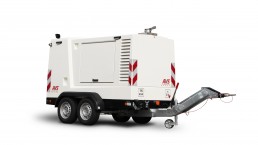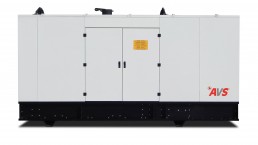A selection of our rental equipment
Our rental park can provide you with a wide range of diesel gensets.
With a performance range of between 15 and 2,000 kVA, we are sure to have something there for you. You can choose between all of the various designs: whether stationary or mobile, soundproof, with emergency or peak load power systems or as floodlight generators. To keep our prices as reasonable as possible, we even adjust these according to how you apply the equipment. Our rental park allows us to provide a secure supply of electricity. Whether you are staging an event, protecting a property or supplying a building site, Our rental park stocks the equipment to suit you. In doing so, we rely on units with a performance of up to 2,000 kVA, and have direct access to additional floodlight generators. We are of course able to provide all the accessories, such as cables, distributors and tank systems.
Whatever accessories you need!
Here you can find a selection of optional accessories you can lease along with each genset.
- 16 mm² 25 / 50 metre performance cables
- 25 mm² 25 / 50 metre performance cables
- 35 mm² 25 / 50 metre performance cables
- 50 mm² 25 / 50 metre performance cables
- 70mm² 5 / 30 / 60 metre* performance cables
- 120mm² 5 / 30 / 60/ 90 metre*, ** performance cables
- 240mm² 5 / 15 metre* performance cables
*Also available as a single conductor; ** May be equipped with a powerlock
- 16A 10 / 25 metre extension cables
- 32A 10 / 25 / 50 metre extension cables
- 63A 10 / 25 / 50 metre extension cables
- 125A 10 / 25 / 50 metre extension cables
- 1 x 70 mm² earthing cable 5 / 10 / 15 / 30 / 60 / 90 metres
- 1 x 120 mm² earthing cable 5 / 10 / 15 / 30 / 60 / 90 metres
- 4 x 125 A distribution boxes
- 6 x 125 A + 2 x 63A distribution boxes
- 2 x 125 A + 2 x 63A + 1 x 230 V distribution boxes
- 1 x 125 A + 2 x 63A + 3 x 230 V distribution boxes
- 1 x 125 A + 1 x 63A + 1 x 32A + 3 x 230 V distribution boxes
- 10 x 63 A distribution boxes
- 2 x 125 A + 8 x 63A distribution boxes
- 4 x 63A + 6 x 230V distribution boxes
- 4 x 63A + 4 x 230V distribution boxes
- 2 x 63A + 2 x 32A + 6 x 230V distribution boxes
- 2 x 63A + 2 x 32A + 3 x 230V distribution boxes
- 2 x 63A + 2 x 32A + 2 x 16A + 6 x 230V distribution boxes
- 6 x 32A + 3 x 230V distribution boxes
- 4 x 32A + 3 x 230V distribution boxes
- 2 x 32A + 2 x 16A + 6 x 230V distribution boxes
- 2 x 32A + 4 x 16A + 6 x 230V distribution boxes
- 6 x 16A + 6 x 230V distribution boxes
- 125 A auf 2 x 63 A distribution block
- 63 A auf 2 x 32 A distribution block
- 32 A auf 2 x 16 A distribution block
Was your distributor not among these? Just ask us directly for details.
- 1.300 l fuel tank
- 1.500 l sub-tank
- 2.400 l fuel tank
- 2.900 l fuel tank
- 5.500 l tank container
- 11.500 l tank container
- 26.000 l tank container
Did you know? Your approximate hourly fuel consumption is easy to calculate: kVA / 5 = litres per hour under full load!
Mobile:
- 2 x 100 kVA
- 2 x 130 kVA
Stationary:
- 2 x 125 kVA
- 2 x 300 kVA
- 2 x 400 kVA
- 2 x 500 kVA
Application 1: Failure protection:
2 x 100 kVA run in parallel operation, supplying a consumer who requires a maximum of 100 kVA. The load is divided up 50:50 between both units. If a unit breaks down, the other unit takes over the complete performance without interruption. Everything runs fully automatically; the operator need not intervene.
A typical example: supply of TV transmissions, mobile hospitals, drinking water supply, and so on.
Application 2: top performance:
to cope with short-term peaks, both units can be connected parallel, although usually only one of them runs. When performance exceeds a certain threshold value, the second unit starts, and doubles the available performance. If the load falls below an arbitrary threshold value, the second unit turns off automatically.
In this way, a lot of fuel can be saved, and background noise and exhaust emissions can be reduced.
Some typical examples: 24 h supply with two daily peak times; day/night operation

